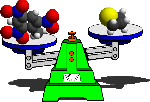 Atomic weight? Atomic weight?
How can you weigh something as small as an atom? Hold it! Let's be careful
with the use of the term weight. Chemists can get rather sloppy with the terms atomic or
molecular weight, rather than the more correct terminology of atomic (molecular) mass.
Weight is the pull of gravity on
an object's mass, so it varies from location to location on earth, though it's not a
great variation. Mass is a measurement of the quantity of matter in an object.
There is no possible way to measure the weight of an atom since it is far
too small to be measured on the most sensitive of scales. However, each atom (and
molecule) does contain a definite quantity of matter, so atomic mass and molecular mass
are the correct terms. Nevertheless you'll still often hear chemists referring to atomic
and molecular weights, and if you find an older textbook you'll undoubtedly run across the
terms.
Ok, atomic mass then, not weight. This still begs the question, "how
can you find the mass of something
as small as an atom?" It must be possible, since a quick glance at any chemistry book
will show very accurate atomic masses, Hydrogen at 1.00794, Oxygen at 15.9994, and so on.
Look closely and you'll see no unit of measurement on those atomic masses. If I told you
that the mass of a book is 2, you might guess that means 2 kg, but there are certainly
other possibilities - 2 pounds is obviously possible. Normally a mass must be reported
with a unit. It doesn't take a lot of deep thought to realize that a hydrogen atom doesn't
weigh 1.00794 g, nor even 1.00794 micrograms. Atoms simply aren't that big.
| Which of the following is an example of a valid statement?
|
Copyright © 1998 - 2008 David Dice
|